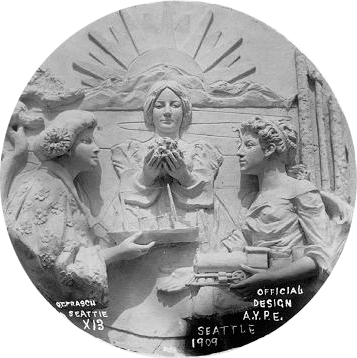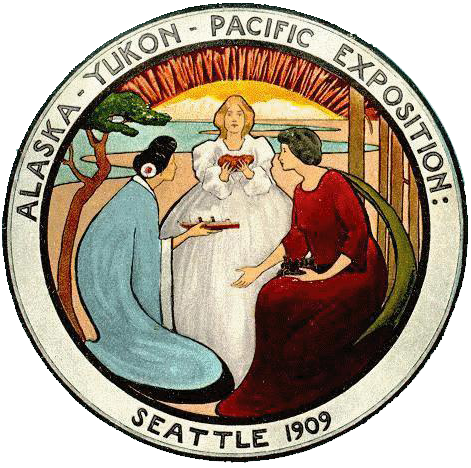ALASKA-YUKON-PACIFIC EXPOSITION
SEATTLE, WASHINGTON USA 1909
Images of the Fair
Yukon Postcard Company
When the Alaska Yukon Pacific Exposition opened in June, 1909, Seattle had just gone through twelve of its most significant years of growth. The arrival of Alaskan gold in 1897 and the subsequent Gold Rush was brilliantly exploited to transform a struggling town into one of the major cities of the West Coast. (The planners had originally hoped for a 1907, or tenth anniversary opening, but it was delayed for the Jamestown exposition.) Construction Image Card from Jamestown
Initially conceived to expand upon Alaskan exhibits at the Lewis and Clark Exposition of 1905, the AYPE's mission was extended to encompass geographical, historical, ethnographic and commercial display of the Pacific Rim. Ribbon The businessmen, political leaders, and citizens who helped see the concept through to fruition hoped to focus commercial attention on Seattle, Flyer Ad Alaska, particular counties, the State of Washington, other states and nations, etc. each according to its level of financing and participation.
With United States Government backing and participation, the AYPE acquired the cachet of an International Exhibition. Comet As an exposition, it played multiple roles in the areas of general education, distribution of specific technical and commercial information about the regions of focus, Schools local certification and promotion, and pleasure for all who attended. At its best, the Exposition helped foster better understanding and relationships between the peoples of the United States and those of other nations of the World, stimulated trade within the country and internationally, CPRR brochure and provided inspiration and entertainment to the local community. At its worst, like all major venues, it was used to exploit popular national and racial stereotypes, Image exposit self-serving political views , and foster the proliferation of cheap, banal entertainment and souvenirs. In the hindsight of almost ninety years, many aspects of these fairs, whether noble or tawdry, are interesting and instructive. Christian Endeavor Booth
The fair took place on the largely undeveloped grounds of the University of Washington. A large portion of the fair's financing was provided by the sale of public lands in the area, and part of its justification was the permanent use of fair buildings as educational structures for the University. The wooded grounds, views of lakes, and the towering presence of glacier-covered Mt. Rainier gave a sylvan setting for the Beaux-Arts buildings and extensive plantings. Because the fair was technically taking place on a school campus, state laws forbid the serving of alcohol on the grounds (exhibitors were however able to provide samples). Despite claims that this would ruin the fair, it was a success, drawing 3,700,000 visitors during its official opening from May 1 to October 16 and earning enough to pay all expenses. Major structures were devoted to Alaska, Hawaii, and the Philippines, the Orient, and Europe. small map of the exposition large map Japan, lobbied by some of Seattle's most distinguished founding fathers, had the largest foreign -built pavillion after Canada's several buildings and many displays.
Since the World's Columbian Exposition of 1893, private enterprise had provided some of the international and educational aspects of American world's fairs in the form of sophisticated sideshows, relegated to their own area. Arena Image At the AYPE this was called the Pay Streak, and included serious exhibits such as the Baby Incubators and the California Indian Museum, stereotypical ones like Streets of Cairo and the ubiquitous Igorrotes, and pure midway hokum such as Albert, the Talking Horse.
The direct impact of the fair on the city of Seattle, Alaska, and the region is not easy to quantify. Most Seattleites today have only a vague impression, if any, of the fair's existence. The Seattle World's Fair of 1962, however, was conceived and created by those who remembered the 1909 exposition, and part of its legacy - the Space Needle - gave the city as memorable of an icon as anything that Madison Avenue could contrive. The fair's beautiful grounds and elegant buildings surely inspired homes, parks, and commercial buildings that were constructed through the 1930s. Investment was strong through the pre-depression era, but the area has traditionally weathered many cycles of boom and bust, both cultural and economic, since it was pioneered in 1851. The pride and confidence that the fair inspired, and continues to inspire in the local community, are intangibles that are difficult to measure. The enthusiasm generated by the fair helped to inspire a week-long, gold-rush theme summer celebration called the Golden Potlatch, whose spirit now lives on in Seattle's Seafair. One highly-touted return from the fair, however - buildings for the University - was not sustained to the degree anticipated. Complaints about the fitness of the buildings for educational purposes arose almost immediately, and within a generation many significant structures were gone. The campus was re-oriented on different axis, and today only a few buildings from the fair remain.
It is the personal opinion of the author that the AYPE represents the greatest cultural event that area has ever experienced. Despite taking place on the heels of an economic downturn, it blossomed in the heart of the Arts and Crafts era, in a world that much more was handbuilt than today, and for this reason its details have timeless visual appeal. It also reflects the values of its period, some of which are different than our own, but no less sincere. Alongside the many aspects of post-Victorian cultural, racial, and gender divisions are as many attempts to inform, reform, integrate, and uplift in all areas of human endeavor and relationship. In viewing its many aspects, it always useful to remember that many thousands of persons were involved in creating and producing it - and its larger aspects, were often represented by persons not under any direct control of the Fair management.
As our region continues to grow and change, it is sincerely hoped that the spirit of personal involvement and contribution, the image of the city beautiful, and the spirit of harmony and cooperation between persons of all nations that was present at the AYPE will not be forgotten.
------------------------------------------------------------------------------------------------------------------------------------------------------------------------------------



O. T. Frasch



